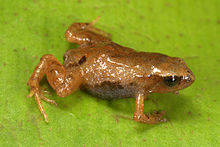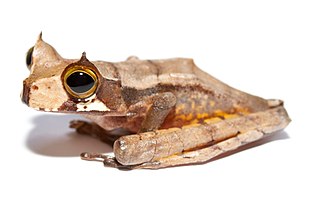
Gastrotheca is a genus of frogs in the family Hemiphractidae. They are found in Central America south of Costa Rica and in South America. Most species occur in the American Cordillera from southern Costa Rica to north-western Argentina. This genus makes up the bulk of marsupial frog diversity; formerly it was placed in the "Leptodactylidae" assemblage.

Phrynopus is a genus of frogs of the family Strabomantidae. Their common name is Andes frogs. They are endemic to Peru and inhabit the upper humid montane forest and supra-treeline grassland in the Cordillera Oriental, with one record from the Peruvian Cordillera Occidental.

Centrolene is a genus of glass frogs in the family Centrolenidae. The adult males are characterized by having a humeral spine, as most members of this family. The delimitation of this genus versus Cochranella is not fully resolved, and some species formerly in Centrolenella — which is nowadays synonymized with Centrolene — are now in Hyalinobatrachium.

Oreobates is a genus of frogs in the family Strabomantidae. Most species were formerly in the genus Ischnocnema, but were moved to this revalidated genus following a 2006 revision. Its sister taxon is Lynchius.
Pristimantis altae, also known as mountain robber frog, is a species of rain frog in the family Strabomantidae with a bright coral-coloured groin. It is found in Costa Rica and Panama.
Oreobates saxatilis, also known as Tarapoto big-headed frog, is a species of frog in the family Strabomantidae. It is endemic to Peru and known from near its type locality near Tarapoto as well as from the Río Tambo District in the Satipo Province, Panguana in the Puerto Inca Province, and Río Kimbiri in the La Convención Province.
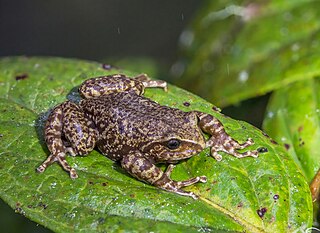
Pristimantis is a very large genus of frogs distributed in the southern Caribbean islands and in Central and South America from Honduras to northern Argentina and southern Brazil. With 596 described species, the genus had more species than any other genus of vertebrate animals. Many of these species genus are endemic to the Northwestern Andean montane forests ecoregion in north-western South America.
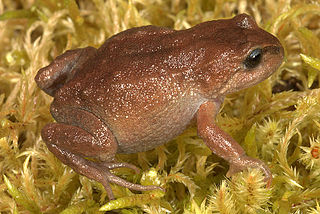
Bryophryne is a genus of frogs in the family Strabomantidae. These frogs are endemic to south-eastern Peru in the Cusco Region, with an undescribed species from the Puno Region. Their range is separated from that of Phrynopus by the Apurímac River valley.

Craugastoridae, commonly known as fleshbelly frogs, is a family of New World direct-developing frogs. As delineated here, following the Amphibian Species of the World, it contains 129 species. They are found from the southern United States southwards to Central and South America.
Oreobates ayacucho is a species of frogs in the family Strabomantidae. It is endemic to Peru and known from a few localities in the Ayacucho Region in the Peruvian Andes. The species is only known from 11 specimens.

Lynchius is a genus of frogs in the family Strabomantidae. The name honours herpetologist John D. Lynch. The distribution of Lynchius is restricted to the Cordillera Oriental in southern Ecuador and Cordillera de Huancabamba in northern Peru.

Yunganastes is a small genus of frogs in the family Strabomantidae found in southern Peru and central to northern Bolivia. They were formerly placed in the genus Eleutherodactylus as the "Eleutherodactylus fraudator group", subsequently moved to Pristimantis, before becoming recognized as a separate subgenus, and finally, a genus. Its sister taxon is the genus Pristimantis. Yunganastes are endemic to the cloud forests and humid montane forests of the Cordillera Oriental of the Andes in Bolivia and southern Peru.

Psychrophrynella is a genus of frogs in the family Strabomantidae The genus is distributed on the Andes of southern Peru and Bolivia. One of the four species assessed by the International Union for Conservation of Nature (IUCN) is assessed as "Critically Endangered".

Niceforonia is a genus of frogs in the family Strabomantidae found in northern South America. The name refers to Nicéforo María, Colombian herpetologist.

Noblella is a genus of frogs in the family Strabomantidae. They are found on the eastern slopes of the Andes and in the Amazon Basin in Colombia, Ecuador, Peru, Bolivia, and western Brazil. The name refers to Gladwyn K. Noble, who described the first species.

Psychrophrynella usurpator is a species of frogs in the family Strabomantidae. It is endemic to Peru and known from near Abra Acjanacu, a mountain pass in the Cordillera de Paucartambo, the easternmost Andean range towards the Amazonian lowlands, and from the high elevation grasslands of the Manu National Park. It is named usurpator, because these frogs were previously misidentified as Noblella peruviana — in a sense, they had "usurped" the name of another frog species.
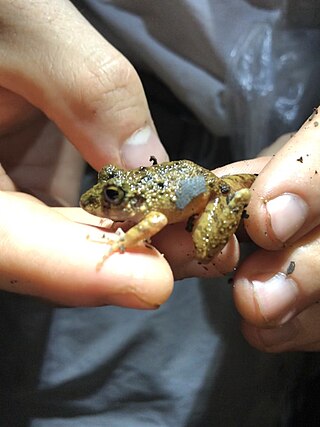
Oreobates amarakaeri, also known as Amarakaeri's big-headed frog is a species of frog in the family Strabomantidae, which is endemic to a small region of south-eastern Peru, in the Manú District, and parts of the Puno Region. The frog was first discovered near the Rio Nusinuscato and Rio Mabe rivers in the Andean foothills of the Amarakaeri Communal Reserve, which are tributaries of the Rio Araza. Since then the species has also been found at the Manú Learning Centre and near Bahuaja Sonene National Park, but weren't fully confirmed to be there until 2019 when four specimens were collected at those localities. At the Manú Learning Centre the frog is known to occur mainly in low disturbance and primary forest habitat, but can also be found near streams in more disturbed areas.
Qosqophryne is a genus of strabomantid frogs. These frogs are endemic to south-eastern Peru in the Cusco Region at 3270 to 3800 meters above sea level. A phylogenetic analysis found Qosqophryne as sister to the genus Microkayla and that this clade was more closely related to Noblella and Psychrophrynella than to other species in Bryophryne.
Microkayla is a genus of frogs in the family Strabomantidae.
